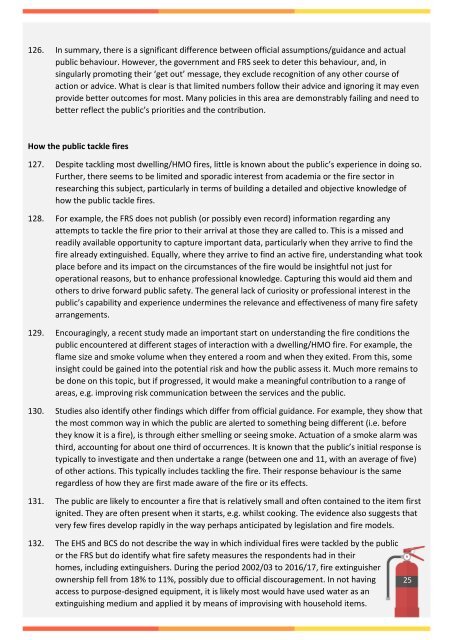An evaluation of the role of fire extinguishers
A report considering the role of a fire extinguisher in human terms identifying the gap between policy assumptions and the evidence from real fires. It considers the implications arising from this and makes a number of recommendations to create an evidence base and enhance current fire safety policies/advice.
A report considering the role of a fire extinguisher in human terms identifying the gap between policy assumptions and the evidence from real fires. It considers the implications arising from this and makes a number of recommendations to create an evidence base and enhance current fire safety policies/advice.
You also want an ePaper? Increase the reach of your titles
YUMPU automatically turns print PDFs into web optimized ePapers that Google loves.
126. In summary, <strong>the</strong>re is a significant difference between <strong>of</strong>ficial assumptions/guidance and actual<br />
public behaviour. However, <strong>the</strong> government and FRS seek to deter this behaviour, and, in<br />
singularly promoting <strong>the</strong>ir ‘get out’ message, <strong>the</strong>y exclude recognition <strong>of</strong> any o<strong>the</strong>r course <strong>of</strong><br />
action or advice. What is clear is that limited numbers follow <strong>the</strong>ir advice and ignoring it may even<br />
provide better outcomes for most. Many policies in this area are demonstrably failing and need to<br />
better reflect <strong>the</strong> public’s priorities and <strong>the</strong> contribution.<br />
How <strong>the</strong> public tackle <strong>fire</strong>s<br />
127. Despite tackling most dwelling/HMO <strong>fire</strong>s, little is known about <strong>the</strong> public’s experience in doing so.<br />
Fur<strong>the</strong>r, <strong>the</strong>re seems to be limited and sporadic interest from academia or <strong>the</strong> <strong>fire</strong> sector in<br />
researching this subject, particularly in terms <strong>of</strong> building a detailed and objective knowledge <strong>of</strong><br />
how <strong>the</strong> public tackle <strong>fire</strong>s.<br />
128. For example, <strong>the</strong> FRS does not publish (or possibly even record) information regarding any<br />
attempts to tackle <strong>the</strong> <strong>fire</strong> prior to <strong>the</strong>ir arrival at those <strong>the</strong>y are called to. This is a missed and<br />
readily available opportunity to capture important data, particularly when <strong>the</strong>y arrive to find <strong>the</strong><br />
<strong>fire</strong> already extinguished. Equally, where <strong>the</strong>y arrive to find an active <strong>fire</strong>, understanding what took<br />
place before and its impact on <strong>the</strong> circumstances <strong>of</strong> <strong>the</strong> <strong>fire</strong> would be insightful not just for<br />
operational reasons, but to enhance pr<strong>of</strong>essional knowledge. Capturing this would aid <strong>the</strong>m and<br />
o<strong>the</strong>rs to drive forward public safety. The general lack <strong>of</strong> curiosity or pr<strong>of</strong>essional interest in <strong>the</strong><br />
public’s capability and experience undermines <strong>the</strong> relevance and effectiveness <strong>of</strong> many <strong>fire</strong> safety<br />
arrangements.<br />
129. Encouragingly, a recent study made an important start on understanding <strong>the</strong> <strong>fire</strong> conditions <strong>the</strong><br />
public encountered at different stages <strong>of</strong> interaction with a dwelling/HMO <strong>fire</strong>. For example, <strong>the</strong><br />
flame size and smoke volume when <strong>the</strong>y entered a room and when <strong>the</strong>y exited. From this, some<br />
insight could be gained into <strong>the</strong> potential risk and how <strong>the</strong> public assess it. Much more remains to<br />
be done on this topic, but if progressed, it would make a meaningful contribution to a range <strong>of</strong><br />
areas, e.g. improving risk communication between <strong>the</strong> services and <strong>the</strong> public.<br />
130. Studies also identify o<strong>the</strong>r findings which differ from <strong>of</strong>ficial guidance. For example, <strong>the</strong>y show that<br />
<strong>the</strong> most common way in which <strong>the</strong> public are alerted to something being different (i.e. before<br />
<strong>the</strong>y know it is a <strong>fire</strong>), is through ei<strong>the</strong>r smelling or seeing smoke. Actuation <strong>of</strong> a smoke alarm was<br />
third, accounting for about one third <strong>of</strong> occurrences. It is known that <strong>the</strong> public’s initial response is<br />
typically to investigate and <strong>the</strong>n undertake a range (between one and 11, with an average <strong>of</strong> five)<br />
<strong>of</strong> o<strong>the</strong>r actions. This typically includes tackling <strong>the</strong> <strong>fire</strong>. Their response behaviour is <strong>the</strong> same<br />
regardless <strong>of</strong> how <strong>the</strong>y are first made aware <strong>of</strong> <strong>the</strong> <strong>fire</strong> or its effects.<br />
131. The public are likely to encounter a <strong>fire</strong> that is relatively small and <strong>of</strong>ten contained to <strong>the</strong> item first<br />
ignited. They are <strong>of</strong>ten present when it starts, e.g. whilst cooking. The evidence also suggests that<br />
very few <strong>fire</strong>s develop rapidly in <strong>the</strong> way perhaps anticipated by legislation and <strong>fire</strong> models.<br />
132. The EHS and BCS do not describe <strong>the</strong> way in which individual <strong>fire</strong>s were tackled by <strong>the</strong> public<br />
or <strong>the</strong> FRS but do identify what <strong>fire</strong> safety measures <strong>the</strong> respondents had in <strong>the</strong>ir<br />
homes, including <strong>extinguishers</strong>. During <strong>the</strong> period 2002/03 to 2016/17, <strong>fire</strong> extinguisher<br />
ownership fell from 18% to 11%, possibly due to <strong>of</strong>ficial discouragement. In not having<br />
access to purpose-designed equipment, it is likely most would have used water as an<br />
extinguishing medium and applied it by means <strong>of</strong> improvising with household items.<br />
25<br />
3




